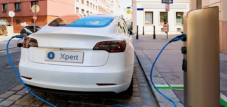Solar obligation is coming – Berlin achieves the 2020 climate target ahead of schedule
Language selection 📢
Published on: December 10, 2020 / update from: March 16, 2021 - Author: Konrad Wolfenstein
The preliminary Berlin energy and CO 2 balance shows a CO 2 reduction of 40.7% for 2019 compared to the base year 1990. The Berlin Energy Transition Act sets the goal of a reduction of 40% in 2020. Despite record economic growth and increasing population Berlin's energy consumption and CO 2 emissions are falling even more. The coal phase-out and Berlin's energy and climate protection program as well as lower emissions from trade and industry are the basis of success.

Berlin achieves its 2020 climate target ahead of schedule – Image: Niklas JM Hoffmann|Shutterstock.com
The preliminary figures for Berlin's energy and CO 2 balance for 2019 presented by the Berlin-Brandenburg Statistical Office show a 1.2% reduction in final energy consumption (EEV) and a 6.7% reduction in CO 2 compared to 2018. Emissions (polluter payer balance). Compared to the base year 1990, Berlin achieved a CO 2 reduction of 40.7%. Many federal states are aiming for a 25% reduction in CO 2 emissions by 2020.
In percentage terms, the temperature-adjusted changes in CO 2 emissions are highest in the areas of private households, commerce, services (-8.9%) and manufacturing (-17.3%). CO 2 emissions in the transport sector remained constant (+0.5%). In terms of EEV, district heating (+1.9%) and renewable energies (+0.9%) in particular increased, while the share of gases fell by -2.4%. Hardly any coal is used in the EEV sector anymore. Consumption in the primary energy sector also fell significantly compared to 2018 (-32.0%). The share of electricity generation from combined heat and power increased to 68.4% of gross electricity generation, while the share of heat generated from cogeneration fell to 58.7% of district heating generation.

Ramona Pop (Martin Rulsch) 1 , Martin Rulsch, Wikimedia Commons , CC BY-SA 4.0 , CC BY-SA 4.0
Ramona Pop, Senator for Economic Affairs, Energy and Enterprises:
“Berlin has set itself ambitious goals for climate protection. I am proud that we achieved our ambitious climate goal in 2019 – before the Corona crisis. In particular, the coal phase-out initiated by the Senate and the Berlin energy and climate program succeeded in reducing real CO 2 emissions by over 1.9 million tons in the years 2017-2019! and thus by almost 10%! to lower. It is a great success that the decline in emissions in Berlin contrasts so positively with the nationwide development despite strong economic and population growth. Berliners can be proud of that. My special thanks go to companies, because above-average reductions have been made in the economy itself. The consistent focus on climate protection is paying off. However, we will not rest on these good figures.
Further ambitious steps remain necessary to achieve the climate goals for 2025 and 2030. With our Solar City master plan, we are setting the right course for this – for example with the solar obligation decided by the Senate.”
With the solar law, Berlin is making further progress in climate protection
Overall, it can be noted that the positive population increase (almost +1.0%) and Berlin's good overall economic development (adjusted for inflation +3.0%) compared to 2018 are not reflected in an equally high increase in EEV and CO 2 emissions.
The energy and CO 2 balance showed CO 2 emissions of almost 20.05 million tonnes for 2016.
The preliminary energy and CO 2 data are available www.statistics-berlin-brandenburg.de

























